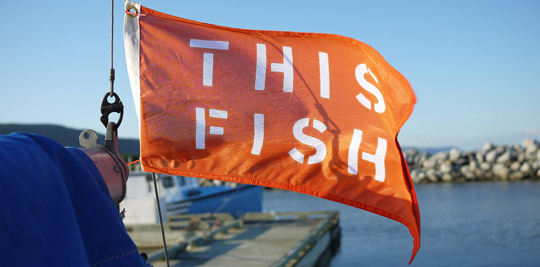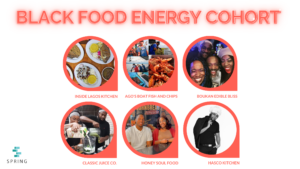Today I sat down with the CEO of ThisFish – Eric Enno Tamm, one of our alumni companies that ended up successfully closing a seed round of over $600,000. We discussed some of the unique challenges he faced while raising capital for ThisFish.
Below is a summary of some key lessons in his entrepreneurship journey and how Eric overcame some of his fundraising challenges.

First, a little bit about ThisFish and what it does:
ThisFish was incubated in EcoTrust, a non-profit charity whose purpose is to build the conservation economy. They also run the co-working space – The AMP, which Spring is a tenant of!

Being neighbours in the same space, we’ve had the opportunity to support ThisFish on their journey since inception.
ThisFish started back in June 2017 and spun-out from EcoTrust as one of their for-profit ventures. Their mission is to utilize software and digitization to help bring more transparency and accountability to the global seafood supply chain. By doing so, they aim to increase sustainable fishing practices and help consumers make better decisions on their seafood purchases.
Their technology is unique, utilizing a mix of hardware and blockchain technology for record keeping+validation, they are revolutionizing an archaic industry where record keeping is done manually through pen+paper and often inaccurately tracked.
You mentioned that you feel your business is different from many others, why do you say that?
#1 We had customers
Most startps are typically the result of founders creating a solution, then going out to seek customers. On the other hand, we had the blessing of starting with customers who had a problem, and we created what we thought would serve them best.
This was a great thing to have as it ensured that we were only building for what our customers needed and were less distracted by what we thought they might want. It didn’t however mean that we started perfect, we still had to pivot our solution a few times as our initial solution was addressing the problem in a very different way from what we’re doing right now.
We’ve shifted from an approach of supporting local fisherman, to a more global approach to addressing the issue of record keeping and traceability in the existing supply chain. This shift in addressable market, also meant that we are opening ourselves to a much larger customer base, revenue model, and potential for growth; which now made it suitable for us to raise capital from investors.
Lesson: Not every company is suited for raising capital from investors. Investors are looking for a return on their investment, you have to prove to them that you can possibly give a high return on their investment, or if it’s going to be low, you have to make it less risky for them.
#2 We are trailblazers
A lot of what we are doing feels very new. It’s not everyday that you see a tech for-profit startup, spin-out of a non-profit, and go on to seek capital from investors in such a short time frame. Most spin-offs will rely more on their parent organization to sustain them while they work to achieve a financially sustainable business model.
The vertical that we are addressing also posed a unique challenge because not many traditional investors are familiar with the seafood industry.
Why a for-profit social enterprise?
It felt like the right thing to do – build a social enterprise driven by market incentives to drive change.
We saw that we are delivering clear value to our clients and could directly charge them. Because this was possible, it meant that we did not need to constantly seeking funding from donors and it allowed us to focus on maximizing value for our end-users instead of having to worry about satisfying donors.
How did you feel about raising capital from investors before working with us?
Fundraising from investors was a completely foreign topic to us, we are familiar with fundraising for non-profits and managing donor expectations, but had never delved into raising from angel investors who are looking for growth and monetary returns.
As you started your Fundraising journey, what was a specific challenge that you came across?
Angel Investors like vanilla ice-cream – they like things plain and simple, things that they’re familiar with. When you’re doing something different, it’s slightly harder to sell your flavour.
As mentioned above, we are different because:
- Non-profit spinoff
- New technology – blockchain
- Seafood industry (unfamiliar to traditional investors)
- A Total Addressable Market (TAM) that seemed too small for a Venture Capital (VC) market – not a unicorn model, different from what most angels and VCs are looking for.
We also wanted to ensure that we could rightfully compensate our parent non-profit for the support they provided and weren’t sure how we could best structure our Capitalization Table (Cap Table) to do so.
So now that you’ve closed your round, what have you learned about the process and what advice can you impart on fellow entrepreneurs?
Lesson: Because we are so different, we felt it was more important than ever to understand the traditional fundraising process so that we could navigate conversations and set expectations with investors in a language and system that was familiar to them. Had we try to raise capital on our own, we would have probably made a bunch of rookie mistakes, jeopardized some investor relationships, and create unnecessary friction that would have made fundraising longer than it should be.
Working with Spring helped us see that there are other avenues for raising capital from investors who are more impact oriented instead of traditional investors who are aiming for a moonshot business.
Lesson: We learned how to leverage the reputation of some of our early investors to bring on other investors.
Lesson: We were exposed to a different paperwork for raising – redeemable shares, which aren’t as commonly used, but allowed us to rightfully compensate EcoTrust while keeping our shareholders happy.
Lesson: Fundraising takes longer than you’d expect. Although our round felt like a relatively smooth process, it still took us about 8 months from start to finish. We are lucky that we had the right advisors to help with setting expectations so that we didn’t end up running out of runway.
Interested in receiving support from us too? Apply to join our Fundraising Roundtables.





